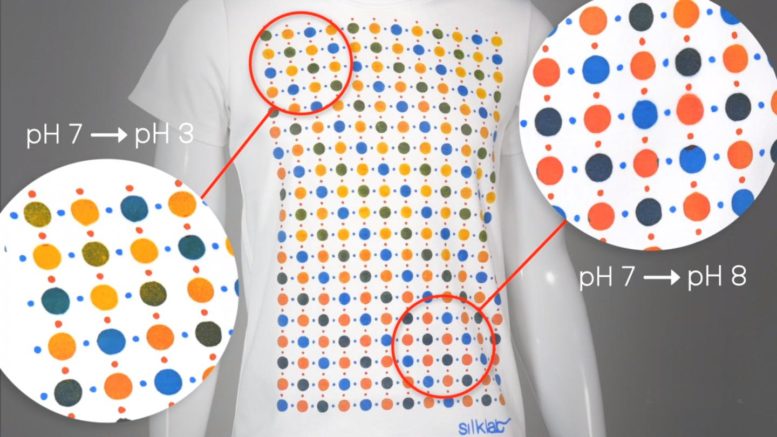A T-shirt screen printed with pH sensitive bio-active inks can provide a map of pH response on the wearer. Variations of bio-active inks can detect other molecules released by the body, or in the surrounding environment. Courtesy of Focus Vision Media and Tufts University
Researchers at Tufts University's School of Engineering have developed biomaterial-based inks that respond to and quantify chemicals released from the body (e.g. in sweat and potentially other biofluids) or in the surrounding environment by changing color. The inks can be screen printed onto textiles such as clothes, shoes, or even face masks in complex patterns and at high resolution, providing a detailed map of human response or exposure. The advance in wearable sensing, reported in Advanced Materials, could simultaneously detect and quantify a wide range of biological conditions, molecules and, possibly, pathogens over the surface of the body using conventional garments and uniforms.
"The use of novel bioactive inks with the very common method of screen printing opens up promising opportunities for the mass-production of soft, wearable fabrics with large numbers of sensors that could be applied to detect a range of conditions," said Fiorenzo Omenetto, corresponding author and the Frank C. Doble Professor of Engineering at Tufts' School of Engineering. "The fabrics can end up in uniforms for the workplace, sports clothing, or even on furniture and architectural structures."
Wearable sensing devices have attracted considerable interest in monitoring human performance and health. Many such devices have been invented incorporating electronics in wearable patches, wristbands, and other configurations that monitor either localized or overall physiological information such as heart rate or blood glucose. The research presented by the Tufts team takes a different, complementary approach - non-electronic, colorimetric detection of a theoretically very large number of analytes using sensing garments that can be distributed to cover very large areas: anything from a patch to the entire body, and beyond.
The components that make the sensing garments possible are biologically activated silk-based inks. The soluble silk substrate in these ink formulations can be modified by embedding various "reporter" molecules - such as pH sensitive indicators, or enzymes like lactate oxidase to indicate levels of lactate in sweat. The former could be an indicator of skin health or dehydration, while the latter could indicate levels of fatigue of the wearer. Many other derivatives of the inks can be created due to the versatility of the silk fibroin protein by modifying it with active molecules such as chemically sensitive dyes, enzymes, antibodies and more. While the reporter molecules could be unstable on their own, they can become shelf-stable when embedded within the silk fibroin in the ink formulation.
The inks are formulated for screen printing applications by combining with a thickener (sodium alginate) and a plasticizer (glycerol). The screen printable bio-inks can be used like any ink developed for screen printing, and so can be applied not just to clothing but also to various surfaces such as wood, plastics and paper to generate patterns ranging from hundreds of microns to tens of meters. While the changes in color presented by the inks can provide a visual cue to the presence or absence of an analyte, use of camera imaging analysis scanning the garments or other material can gather more precise information on both quantity and high resolution, sub-millimeter mapping.
The technology builds upon earlier work by the same researchers developing bioactive silk inks formulated for inkjet-printing to create petri dishes, paper sensors, and laboratory gloves that can indicate bacterial contamination by changing colors.
"The screen printing approach provides the equivalent of having a large, multiplexed arrangement of sensors covering extensive areas of the body, if worn as a garment, or even on large surfaces such as room interiors," said Giusy Matzeu, research assistant professor of biomedical engineering at Tufts School of Engineering and first author of the paper. "Coupled with image analysis, we can obtain a high-resolution map of color reactions over a large area and gain more insight on overall physiological or environmental state. In theory, we could extend this method to track air quality, or support environmental monitoring for epidemiology."
The fact that the method uses common printing techniques also opens up avenues in creative applications - something explored by Laia Mogas-Soldevila, architect and recent PhD graduate at Tufts in Omenetto's SilkLab. Mogas-Soldevila has helped to create beautiful tapestries, displaying them in museums across the United States and Europe. The displays are interactive, allowing visitors to spray different, non-toxic chemicals onto the fabric and watch the patterns transform. "This is really a great example of how art and engineering can gain from and inspire each other," said Mogas-Soldevila. "The engineered inks open up a new dimension in responsive, interactive tapestries and surfaces, while the 1,000-year old art of screen printing has provided a foundation well suited to the need for a modern high resolution, wearable sensing surface."
Source: Tufts University

I am really loving the theme/design of your site. Do you ever run into any internet browser compatibility problems? A couple of my blog audience have complained about my website not operating correctly in Explorer but looks great in Safari. Do you have any solutions to help fix this issue?
Wow that was odd. I just wrote an really long comment but after I clicked submit my comment didn’t show up. Grrrr… well I’m not writing all that over again. Anyway, just wanted to say fantastic blog!
Every weekend i used to pay a visit this web site, as i want enjoyment, as this this website conations in fact nice funny data too.
Great article, exactly what I wanted to find.
I like the valuable information you provide in your articles. I will bookmark your weblog and check again here frequently. I am quite certain I will learn a lot of new stuff right here! Good luck for the next!